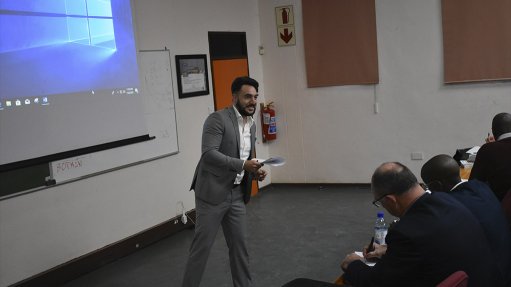
A HEALTHY TURNOUT The Mine Health and Safety Project has had a successful run so far, warranting a renewal after 2020
The South African-German Chamber of Commerce and Industry’s (SAGCCI’s) Mine Health and Safety Project is heading into its third and final year this year.
The project was initiated in 2018 as part of the SAGCCI’s Competence Centre for Mining and Mineral Resources Southern Africa, which was instituted in South Africa in 2013. The Competence Centre will be exhibiting at the Investing in African Mining Indaba this year alongside the SAGCCI, which will also be hosting a German Day at the event.
SAGCCI mining and mineral resources project manager René Zarske hopes that the Mine Health and Safety Project can be extended beyond 2020, as he believes that it has been successful thus far.
“The project has proven valuable and necessary in terms of creating awareness on issues of health and safety in mining in Southern African countries that do not necessarily have very progressive health and safety legislation in place,” he says.
The Mine Health and Safety Project, which is an awareness and training initiative aimed primarily at mine health and safety officers, will host its final six workshops and seminars this year.
In 2018, the project focused less on workshops and more on researching and writing a detailed and informative report on mining health and safety best practices in South Africa.
The ‘Health and Safety on South African Mines: A Best Practice Report’ was published in 2018, and is being used to inform and influence the rest of the Southern African Development Community (SADC) region, with view to adopting these practices.
The report assessed South Africa’s Mine Health and Safety Act (MHSA), as well as the best German technologies for mine health and safety applications.
It also evaluated the efficacy and impact of the Vision Zero initiative, as well as its seven golden rules for harm prevention, of the International Social Security Association’s mining division.
The report looked at Minerals Council South Africa’s best practices in terms of fall-of-ground and dust management, as well as its ledging and silicosis prevention policies.
Following the publication of the report, three mine health and safety workshops were held in South Africa in Johannesburg, Emalahleni and Kathu, while one seminar was held in Sowa, Botswana, and another in Lesotho, last year.
Zarske says that the turnout for the workshops and seminars has been better than expected.
“In Botswana, for example, we were expecting about 20 mine health and safety officers to attend, but, on the day, we were pleasantly surprised to see about 40,” he says.
The workshops and seminars, which are free of charge for attendees, are organised and marketed in collaboration with the Minerals Council, as well as with various chambers of mines throughout the SADC region.
Zarske notes that the next step for the project, if it is extended, is to find ways of measuring and highlighting cases where the preventive health measures, principles and policies advised throughout the seminars and workshops were implemented successfully.
He adds that the best practices are related to South Africa’s MHSA, which is a benchmark for other SADC countries.
“Countries such as Botswana and Lesotho do not have comparable legislation in place. We feel it is important to help them become aware of what is being done in South Africa.”
He explains that there is a “huge gap” between the health and safety standards of South Africa’s mining industry and in those of the rest of the SADC region.
The identification of this gap throughout the course of the Mine Health and Safety Project is one of the reasons that Zarske believes that it should renewed.
He says that, with this particular project, the SAGCCI did not want to merely implement projects in SADC countries as foreign investors “telling people what to do”, but rather engage with the mining communities to understand and help tackle health and safety issues that are unique to their country or set of circumstances.
Zarske says that, as a relatively mineral-resource-scarce country, Germany has a vested interest in the SADC region’s resource exports to sustain Germany’s manufacturing sector – the backbone of its economy – and “responsibly source its resources”.
He says the responsible development of the SADC mining markets will contribute to the security and diversity of the German resource supply and cement these regions as markets for German technology, products and services.
The Competence Centre for Mining and Mineral Resources Southern Africa is funded by the German Federal Ministry of Economic Development and Energy. It is aligned with the resource strategy of Germany and is run by Zarske and the SAGCCI mining and industry project manager Gerard Mohapi.
The centre’s main focus is on Southern Africa, specifically South Africa, Zambia, Zimbabwe and the Democratic Republic of Congo, where mining plays an important role in the economy.
The centre aims to be the central point of contact for German companies in Southern Africa and serves to create market transparency, as well as promote cooperation and communication while providing services and promoting German technologies.